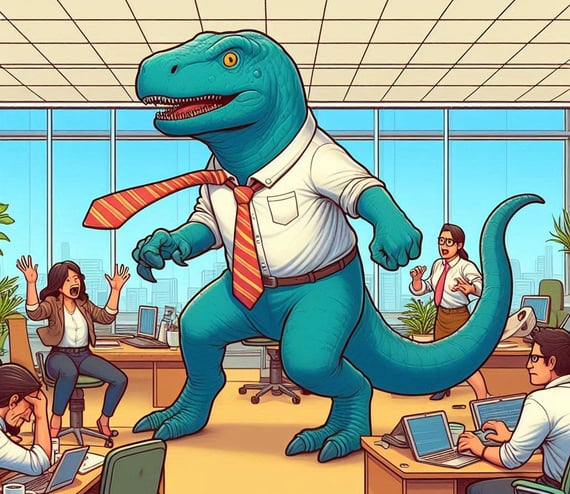The Leadership Dinosaur
The higher you climb in an organization, the more you become a dinosaur - but probably not in the way you think. How can you avoid causing unintended damage to the organization due to your outsized impact?
Jim Butler
1/25/20252 min read


“As a leader grows more senior, his bulk and tail become huge, but like the brontosaurus, his brain remains modestly small. When plans are changed and the huge beast turns, its tail often thoughtlessly knocks over people and things.”
Gen. Stanley McCrystal, US Army
One of my favorite analogies about leadership comes from General Stanley McChrystal’s book, Team of Teams. In it, McChrystal likens the role of leadership to that of a dinosaur unknowingly wreaking havoc on an organization:
“As a leader grows more senior, his bulk and tail become huge, but like the brontosaurus, his brain remains modestly small. When plans are changed and the huge beast turns, its tail often thoughtlessly knocks over people and things.”
This metaphor captures a common dynamic many of us have experienced in organizations. A sudden change in leadership’s plans can lead to significant loss—of time, money, energy, and morale. These losses can’t always be recouped, and the ripple effects can be profound.
The Challenges of Sudden Leadership Shifts
1. Erosion of Team Member Engagement
When priorities shift unexpectedly, team members often feel their hard work has been disregarded. This is more than frustrating—it’s demoralizing. People are less likely to fully invest their time and energy in the future if their contributions are frequently cast aside for shifting goals.
Leaders, through their actions, norms, and behaviors, set the tone for prioritization. When priorities are unclear or change without warning, the team’s ability to focus and deliver is compromised. Over time, this confusion can lead to disengagement and a lack of trust in leadership’s direction.
2. Misaligned Resource Allocation
Frequent, reactive shifts in focus can also signal a disregard for organizational resources. While reallocating resources when new opportunities arise is sometimes necessary, doing so without thoughtful consideration creates confusion. Team members may struggle to understand where they should be investing their efforts to align with the organization’s long-term goals.
Reactive leadership, as opposed to proactive, strategic planning, leaves teams questioning the value of their work and whether they’re truly contributing to the mission.
How Leaders Can Avoid the Dinosaur Trap
To prevent unintended destruction, leaders must approach their roles with intention and self-awareness. Here are three strategies to help avoid the pitfalls described in McChrystal’s analogy:
Clearly Communicate Priorities
Ensure that your team understands your goals and priorities. Regularly articulate what matters most, and explain the reasoning behind your decisions. This transparency builds trust and helps your team focus their efforts where they will have the greatest impact.Plan Thoughtfully and Follow Through
Before committing to a direction, ensure you have thoroughly considered its feasibility. Once a plan is set, stick to it unless an extraordinary need arises. Consistency in leadership fosters stability and confidence among team members.Recognize the Work Behind the Scenes
Leaders often underestimate the effort required to support their decision-making. Acknowledge and appreciate the planning, coordination, and groundwork your team provides. This recognition not only boosts morale but also reminds leaders to weigh the cost of last-minute changes more carefully.
McChrystal’s analogy concludes with a stark reminder:
“That the destruction was unintentional doesn’t make it any better.”
While course corrections may sometimes be necessary, we must recognize the consequences of our decisions and strive to minimize their unintended impact. Leadership requires more than vision—it demands humility, empathy, and thoughtful action.
